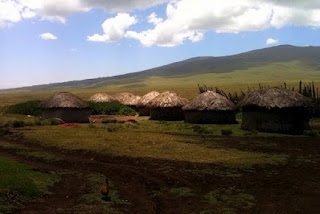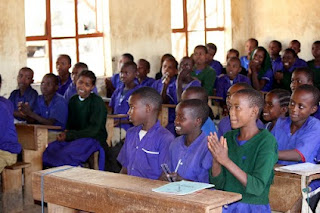Notice the sharp poles that surround the enclosure. This "fence" is made from special trees with sharp thorns to prevent animals from coming into the living areas.

The Maasai are nomadic, so will move from these dwellings every 5 years or so. This is necessary because they depend on good grazing for their cattle. Once the plain is grazed, they must move on and they leave their homes behind.
One day Clamian asked us if we wanted to visit his Uncle's Boma. Of course we did! We entered the Serengeti Plain and made our way towards a distant hill, seeing all kinds of amazing things on the way.
The Serengeti is vast and there are roads all over the place. How they ever find their way around there is beyond me. At one point, Clamian said to us, "We're lost right now, but we'll figure out where we are later, OK?"
No problem! We knew the boma was at the foot of a distant hill -- it was pretty easy to keep the target in site.
These two hyenas are waiting for a chance at lunch!
Ostriches were easy to spot and there were lots!
After a long drive and lots of animals, we arrived at the boma to a heartfelt welcome.
This lady is a relative of Clamian's, an aunt I think, but he called her his "Mama". He hadn't seen her for 20 years.
She was so happy to see him. It was very touching to witness this tearful reunion. Unfortunately Clamian's uncle was away, but we were welcomed with open arms and invited to go wherever we wanted and to take pictures of anything we wanted to.
We knew this was not a "tourist" attraction, but the real thing. What a privilege for us!
Some people were happy to have their pictures taken.
These young girls were a bit shy and reluctant, but they did enjoy seeing their pictures once we had taken them. They don't see a lot of tourists.
We were invited inside one of their dwellings. The typical home is one room and does not have lights, windows, floors or furniture. Food is cooked over an open fire in the middle and there is an opening in the cone-shaped roof to let the smoke out. Beds are made on platforms and cattle have a place too. The people spend their time outside during the day and at night the only light comes from the fire. It took awhile for our eyes to adjust from the bright sunlight to the darkness inside.
This lady was very hospitable and through Clamian, showed us around her home.
It's pretty dark inside, but look at the beautiful bead work! Just a typical day at home!!
It was time to say goodbye and one of Clamian's cousins asked if we could give her a ride as we were going her way. She and Clamian had a long conversation and he later explained that a couple of weeks earlier, 2 small children disappeared from the Boma during the day. It was feared that they were taken by a leopard. So sad, but reality of life in the Boma.
See my next blog for pictures of birds and animals. The diversity is incredible. What a country Tanzania is -- so rich in culture and nature!


























